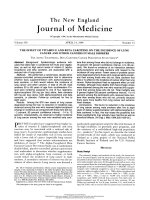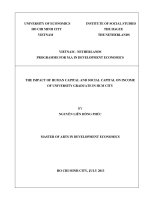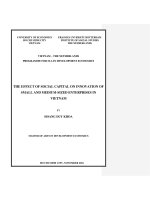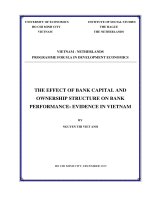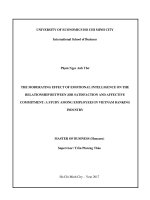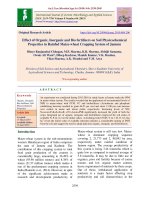The effect of bank capital and ownership structure on bank performance evidence in vietnam
Bạn đang xem bản rút gọn của tài liệu. Xem và tải ngay bản đầy đủ của tài liệu tại đây (1.69 MB, 98 trang )
UNIVERSITY OF ECONOMICS
INSTITUTE OF SOCIAL STUDIES
HO CHI MINH CITY
THE HAGUE
VIETNAM
THE NETHERLANDS
VIETNAM - NETHERLANDS
PROGRAMME FOR M.A IN DEVELOPMENT ECONOMICS
THE EFFECT OF BANK CAPITAL AND
OWNERSHIP STRUCTURE ON BANK
PERFORMANCE: EVIDENCE IN VIETNAM
BY
NGUYEN THI VIET ANH
HO CHI MINH CITY, DECEMBER 2015
VIETNAM - NETHERLANDS PROGRAMME
FOR M.A IN DEVELOPMENT ECONOMICS
THE EFFECT OF BANK CAPITAL AND
OWNERSHIP STRUCTURE ON BANK
PERFORMANCE: EVIDENCE IN VIETNAM
------------------o0o----------------
Thesis
Instructor: Dr. Nguyen Thi Thuy Linh
Student:
Nguyen Thi Viet Anh
CLASS 20
Ho Chi Minh City, December 2015
DECLARATION
I, Nguyen Thi Viet Anh hereby declare that this thesis is my own work under the guidance
of instructor, Dr. Nguyen Thi Thuy Linh. It has not yet been presented and will not be
presented to any similar or other degrees.
Date: 2nd December 2015
Signature
Nguyen Thi Viet Anh
i
ACKNOWLEDGEMENTS
First and foremost, I would like to express my sincere thanks to my main
supervisor, Dr. Nguyen Thi Thuy Linh, for her candid comments, helpful hints and
valuable scientific guidance during times of deployment, research and completion
of this thesis.
I am greatly indebted to the Board of Directors, the teachers and all staff in
Vietnam-Netherlands Programme for M.A in Development Economics– VNP, for
their directly teaching, conveying knowledge and experiences as well as supporting
me and my class-mates necessary information in the last two years.
I express my heartfelt thanks to General Director of Asia Commercial Bank - Mr.
Do Minh Toan, the Board of Managers of ACB Saigon Branch – Mr. Ngo Tan Long
and Ms. Bui Thi Anh Hoa for advice and creation of all favorable conditions for my
work to attending VNP.
I am grateful to Dr. Pham Phu Quoc and Dr. Truong Dang Thuy, who suggested
research topic and gave me enthusiastic guidance in the early stages of writing the
concept note and thesis research design.
I greatly express my special thanks to my colleagues at The Center for Corporate
Credit and Financial Institutions – Asia Commercial Bank, ACB Securities
Company – ACBS, for supporting me in collecting data; colleagues at ACB Saigon Branch, especially Corporate Department, for being always cooperative,
enthusiastically supporting and encouraging me.
I would like to acknowledge the enthusiastic help of fellow practitioners VNP Class 20, especially these members, Nguyen Son Kien, Vo Tan Thanh Diep,
ii
Nguyen Le Phuong Linh, Nguyen Phuong Tram and Vu Thi Thuong, for being my
close companions during the last two school years.
Finally, I wish to dedicate this thesis for my family, my parents, siblings, especially
my dear husband, Nguyen Hoang Than for trust, love, sharing, help, following,
encouragement and being always beside me. I would also like to thank my lovely
children, little daughter, Nguyen Hoang Viet Ha and little son, Nguyen Hoang
Quan. You are the endless motivation that helps me overcome all difficulties and
move forward.
iii
ABSTRACT
This study aimed at assessing the impact of capital structure and ownership
structure on Vietnamese bank performance. The study used secondary data of fortynine Vietnamese banks with 387 observations in the period 2005-2014, employing
Feasible General Least Square as well as Discoll-Kraay Robust for cross-sectional
dependenceestimation. Empirical results show that capital structure is significantly
and positively related to Vietnamese bank performance. Meanwhile, ownership
structure impact negatively on profitability of Vietnamese banks (measuring by
returns on total assets). The findings indicate that the profitability of the Private
Banks is higher than the State-owned ones.
Keys words:Bank performance, Capital structure, Ownership structure, Net Interest
Margin, Returns on Assets, Returns on Equity.
iv
TABLE OF CONTENTS
DECLARATION ....................................................................................................... I
ACKNOWLEDGEMENTS .....................................................................................II
ABSTRACT ............................................................................................................ IV
LIST OF TABLES .............................................................................................. VIII
LIST OF FIGURES ............................................................................................... IX
LIST OF ABBREVIATIONS.................................................................................. X
CHAPTER 1:INTRODUCTION .............................................................................1
1.1
Problem Statement .........................................................................................1
1.2
Research Objectives .......................................................................................4
1.2.1
General research objective ........................................................................4
1.2.2
Specific research objectives .......................................................................5
1.3
Research questions .........................................................................................5
1.4
Significances of the study ..............................................................................5
1.5
Scope of the Study ..........................................................................................6
1.6
Thesis structure .............................................................................................. 6
CHAPTER 2:LITERATURE REVIEW .................................................................7
2.1
Introduction ....................................................................................................7
2.2
Conceptual Definitions ..................................................................................7
2.2.1
Capital Structure ........................................................................................7
2.2.2
Ownership structure ..................................................................................9
2.2.3
Bank performance ......................................................................................9
2.3
2.3.1
Theoretical review ........................................................................................11
Capital structure theory developed by Modigliani and Miller (MM
Model) ....................................................................................................................11
2.3.2
The trade – off theory ..............................................................................12
2.3.3
Agency cost theory....................................................................................13
2.4
2.4.1
Empirical review ..........................................................................................14
Bank capital structure and Bank performance .....................................14
v
2.4.2
2.5
Ownership structure and bank performance ........................................17
Conceptual Framework ...............................................................................19
CHAPTER 3:RESEARCH METHODOLOGY ..................................................20
3.1
Introduction ..................................................................................................20
3.2
scope of Study ............................................................................................... 20
3.3
Epirical model .............................................................................................. 21
3.3.1
Bank performance measures: .................................................................21
3.3.2
The Models ................................................................................................23
3.4
Methodology .................................................................................................30
3.4.1
The Pooled OLS method ..........................................................................30
3.4.2
The Fixed Effects Model (FEM) .............................................................31
3.4.3
The Random Effects Model (REM) ........................................................32
3.4.4
Relevant tests to choose the most appropriate estimation method ......33
3.4.5
The Feasible Generalized Least Square (FGLS) ...................................34
3.4.6
Discoll-Kraay Robust for cross-sectional dependence – XTSCC ........35
3.4.7
Problem of Endogeneity ...........................................................................36
CHAPTER 4:EMPIRICAL
FINDINGS
AND
ANALYSIS
...................................................................................................................................37
4.1
Introduction ..................................................................................................37
4.2
The overview on Vietnamese banks ........................................................... 37
4.3
Descriptive statistics .....................................................................................44
4.4
Empirical results ..........................................................................................47
4.4.1
Explanatory variables and bank performance ......................................47
4.4.2
Control variables and bank performance ..............................................49
4.5
Robustness test - common panel data methods .........................................50
CHAPTER 5:CONCLUSIONS
AND
POLICY
IMPLICATIONS
...................................................................................................................................56
5.1
Main findings ................................................................................................ 56
5.2
Policy implications .......................................................................................56
vi
5.3
Limitation of the study ................................................................................58
5.4
Suggestions for further studies ...................................................................58
REFERENCES ........................................................................................................59
APPENDIX ..............................................................................................................69
vii
LIST OF TABLES
Table 2-1 – Indirect performance indicators for financial institutions .......................9
Table 3-1 Definitions of variables in equation 3.2....................................................28
Table 4-1 Summary statistics for variables ............................................................... 45
Table 4-2 Correlation ................................................................................................ 46
Table 4-3 Vif index ...................................................................................................46
Table 4-4 Results from feasible generalized least square (fgls) and discoll-kraay
robust for cross-sectional dependence (xtscc) ..........................................................47
Table 4-5 Regression result of nim model ................................................................ 51
Table 4-6 Regression result of roa model .................................................................52
Table 4-7 The results of f test and breusch – pagan test ...........................................53
Table 4-8 Hausman test ............................................................................................. 53
Table 4.9 Test of heteroskedasticity .........................................................................54
Table 4.10 Test of autocorrelation ............................................................................54
viii
LIST OF FIGURES
Figure 2-1 Components of Capital Structure ......................................................................... 8
Figure 2-2 Static trade-off theory of capital structure ......................................................... 13
Figure 2-3 Conceptual Framework ...................................................................................... 19
Figure 4-1 Banks' Charter Capital updated to December 31th, 2014 .................................. 38
Figure 4-2 Vietnamese banks’ total assets in the period 2005-2014 ................................... 39
Figure 4-3 Vietnamese banks’ total equity capital in the period 2005-2014 ....................... 40
Figure 4-4 The Return on Total Assets of the Vietnamese banks in the period 2005-2014 41
Figure 4-5 The Return on Total Equity of the Vietnamese banks in the period 2005-2014 42
Figure 4-6 The Net Interest Margins of the Vietnamese banks in the period 2005-2014 ... 43
Figure 4-7 The average equity ratio and ROA, ROE, NIM of the Vietnamese banks in the
period 2005-2014 ................................................................................................................. 44
ix
LIST OF ABBREVIATIONS
DEA
Data Envelopment Analysis technique
FEM
Fixed Effects Model
Pooled OLS
Pooled Ordinary Least Squares
REM
Random Effects Model
ROA
Returns on Total Assets
ROE
Returns on Total Equity
FGLS
Feasible Generalized Least Square
XTSCC
Discoll-Kraay Robust for cross-sectional dependence
x
Chapter 1:
1.1
INTRODUCTION
PROBLEM STATEMENT
One of the main causes leading to the global financial crisis in 2007-2008 period is
the weakness of the banking system. In particular, it might be due to the credit
institutions do not comply strictly with the regulations on capital adequacy
(Norgren, 2010). Due to the severe consequences of the global financial crisis and
their long-term effects on the global banking and financial system, the Basel
Committee on Banking Supervision drafted and promulgated the third edition
(Basel III) with changes and improvements in order to stabilize the banking system
as the main objectives. Focusing on raising equity capital standards, Basel III aims
at three major issues. First, it requires an increase in the minimum common equity
capital ratio from 2% to 4.5%. Second, while the minimum total capital is
maintained at 8%, the high-quality capital standards, i.e. equity capital and Tier 1
capital standards have been increased. Specifically, the minimum Tier 1 capital
increases from 4% in Basel II to 6% in Basel III. Besides, the assets with inherent
quality issues will be gradually eliminated from Tier 1 capital and Tier 2 capital, as
these investments exceed the limit of 15% of financial institutions. In particular, the
Basel III requirements apply additional minimum leverage ratio of 3%. This is the
ratio of Tier 1 capital to total assets plus off-balance sheet items. Applying this ratio
allows the Basel Committee on Banking Supervision to monitor changes in
financial leverage ratio that the banks make in accordance with economic cycles
and the relationship between capital requirements and leverage ratio.
In Vietnam, after the global financial crisis, Vietnamese commercial banks were
exposed to many problems of instability. One of the most important factors
affecting the competitiveness of Vietnamese commercial banks was the weak
financial capability, especially the extremely low level of equity capital. With the
aim of enhancing the banking system performance and stability, on March, 1st,
1
2012, the Prime Minister issued the plan to restructure the system of banks and
other credit institutions during the period 2011-2015 with Decision 254 / QĐ-TTg.
According to this process, the Prime Minister required the Ministry of Finance
combine with the State Bank of Vietnam to approve plan to increase charter capital
of State-owned Commercial Banks. From 2008 until now, Vietnamese commercial
banks have actively increased their registered capital to meet the regulatory
requirement of capital under the provisions of Decree No.141 / 2006 / ND-CP and
Decree 10/2011 / ND-CP dated 26/01/2011 on amending and supplementing some
articles of Decree 141. To achieve such requirement, all commercial banks
implemented different approaches, such as selling shares to domestic or foreign
shareholders, merging with other joint stock commercial bank(s).
Besides that, Decision 254/QĐ-TTg also required State-owned Corporations
gradually exit their investment capital in the credit institutions. The equitization of
state-owned commercial banks and decreasing state-owned capital in these bank are
also seen as a solution to reduce state ownership and increase the capacity of the
banks based on various ownership structures (state, economic entities and
individuals come from foreign countries) aiming at increasing competitiveness.
There are many studies examining the impact of capital structure as well as
ownership structure on bank performance.
Based on agency problem (Jensen and Meckling, 1976), the agency view suggests
that the banks with higher equity capital ratio have lower profitability (Berger and
Di Patti, 2006). Bank management suffers less pressure to maximize the value of
the banks which maintain higher equity capital ratio. This causes conflicts between
management and shareholders so agency cost increases.
On the other hand, many other researches prove that well-capitalized capital
impacts positively on bank performance. Using US banking system data in period
1984: Q.1 – 2010: Q.4, N.Berger and Bouwman (2013) suggested that equity capital
enhances bank performance through three channels. Higher equity capital banks
2
require managers to monitor more and choose safer portfolios to invest. Bank with
higher equity capital can make customers, investors and other partner believe that it
is more reliable and safer so the banks can mobilize deposit money with lower
interest rates as well as increase the volume of loans. Therefore they can improve
performance and increase market share as well. Supporting this view, DemirgüçKunt & Huizinga (1999); Maudos & Guevara (2004); Fiordelisi et al., (2011);
Chortareasa et al., (2012) remark that higher equity capital ratio can improve bank
efficiency. Study on determinants of Net Interest Margin in Vietnamese
Commercial Banks, Thu and Huyen (2014) indicate that leverage impacts positively
on Net Interest Margin. However, their study uses data for thirty-three commercial
banks in the period 2008-2011 with lower observations than my one. Phuc (2014)
uses the data of 217 companies listed on the Ho Chi Minh City and Ha Noi Stock
Exchange in the period 2007 to 2012 to study the effects of capital structure on the
performance of the company after equitisation. The findings show that long-term
debt has a positive impact on ROA and ROE, while short-term debt and total debt
have a negative impact on business performance measured by ROA and ROE.
Research on the relationship between ownership structure and bank efficiency by
using cost and profit frontier approach to examine efficiency of banks with different
ownership types in German, Altunbas, Evans et al. (2001) shows that public banks
are less efficient than privately owned banks. Study on ownership structure reform
in Nigeria in period 2004-2006, Ani, Odo et al. (2012) points out that government
ownership is negatively correlated with bank performance. Uses data for
commercial banks in 179 countries around the world in period 1995-2002 to
examine the relationship between ownership and bank performance, Micco, Panizza
et al. (2007) concludes that, in developing countries, the performance of stateowned banks is lower than their private counterparts because their profitability are
lower while non- performing loans and overhead cost are higher. However, Fuentes
and Vergara (2007) points out the opposite conclusion that it still exist one state-
3
owned bank that is more efficiency than privately owned banks in Chile banking
system in 1990–2004 period.
On the impacts of the ownership structure as well as capital structure on Vietnamese
bank performance, there are many researches including the study of Son, Tu et al.
(2015). However, most of these studies use data with shorter and earlier time
periods. For example, Son, Tu et al. (2015) use data of thirty – four banks with one
hundred and two observations in the period 2010-2012 while this study uses data of
forty-nine banks with three hundred and eighty-seven observations in the period
2005-2014.This study describes the construction of larger data on Vietnamese
banking sector in comparison with previous studies, including larger number of
observed banks in longer time period.
Although there have been many studies on the impact of capital structure and
ownership structure on Vietnamese bank performance, they still at earlier stage and
ues smaller dataset. The mixed results and inconclusive literature motivates this
study on the impact of capital structure and ownership structure on bank
performance using Vietnamese data during the period from 2005 to 2014.
Particularly, the bank performance is reviewed through two proxies: Net Interest
Margin (NIM) and Returns on Assets (ROA).
1.2
RESEARCH OBJECTIVES
1.2.1 General research objective
Under the scheme to restructure the Vietnamese banking system in 2010-2015
periods, two out of four solutions given by Vietnamese Government to improve the
operational efficiency of the banking system are increasing equity capital and
equitization of state-owned commercial banks. This plan is going into the final
stage. In order to investigate the relationship between capital structure, ownership
structure and bank performance, I carry out this research.
4
1.2.2 Specific research objectives
This thesis aims at the following two specific research objectives to achieve the
above general research objective:
The first one is to evaluate the impact of capital structure on Vietnamese bank
performance.
The second one is to investigate the effect of ownership structure on Vietnamese
bank performance.
1.3
RESEARCH QUESTIONS
This study focuses on answering the following two research questions.
Research question 1: Does bank capital structure impact on Vietnamese bank
performance?
Research question 2: Does bank ownership structureeffect onVietnamese bank
performance?
1.4
SIGNIFICANCES OF THE STUDY
This study aims at testing the impact of capital structure as well as ownership
structure on Vietnamese bank performance. Based on the results, the study offers
some suggestions for the State Bank of Vietnam for its policies related to
requirements in raising equity capital, as well as changing in ownership structure
based on recommendations of Basel Committee on Banking Supervision and
consistent with activities of commercial banks in Vietnam. This study also supports
Vietnam commercial banks to find an appropriate solution to build up a suitable
capital structure, ownership structure to improve bank performance.
5
1.5
SCOPE OF THE STUDY
The Vietnamese banking system has a total of fifty banks, including one Wholly
State - Owned Commercial Bank, thirty-four Joint – Stock Commercial Banks in
which there are three banks which the government owns more than 50% of the
banks’ charter capital but is not the only shareholder, five Wholly Foreign Owned
Banks, two Policies Bank, four Joint-Venture Banks, one Cooperative Bank and
forty-nine Foreign Bank Branches updated to December 31th, 2014.
This study focuses on forty-nine banks (whose names are listed in Appendix 1) for
which during the period from 2005 to 2014 are available. This limit is due to the
fact that I cannot collect complete financial statements of Joint-Venture Banks,
Policies Bank, Cooperative Bank, Wholly Foreign Owned Banks as well as the
Foreign Bank Branches. The selected banks also have limited data in some years
during the sample period. Thus, the final sample only includes 387 bank-year
observations (unbalanced panel data).
1.6
THESIS STRUCTURE
This thesis consists of five chapters:
Chapter 1: Introduction
Chapter 2: Literature review
Chapter 3: Research Methodology
Chapter 4: Study findings and analysis
Chapter 5: Conclusion and policy implications
In which, Chapter 1 introduces the research objectives. Chapter two presents the
literature review. In this chapter, some conceptual definations, previous findings of
other authors related totopic are introduced. Chapter three introduces the research
methodology employed in this study. Chapter four presents and analyzes the
findings. Chapter 5 concludes the thesis as well as provides some policy
implications and suggests further research.
6
Chapter 2:
2.1
LITERATURE REVIEW
INTRODUCTION
This chapter introduces some conceptual definitions of capital structure, ownership
structure as well as bank performance measures such as net interest margin and
returns on total assets. It also synthesizes the theoretical and empirical literatures
related to the thesis’s research objectives. The chapter builds up a conceptual
framework on the relationship between capital structure, ownership structure and
bank performance.
2.2
CONCEPTUAL DEFINITIONS
2.2.1 Capital Structure
The capital structure is a term used to describe the origin and method of forming the
capital to the business can be used for purchase of assets, tangible material means
and support for production and business activities. There are many different
definitions of capital structure.
For example, according to Chandra (2011, p.464): “Capital structure is how a firm
decides to divide its cash flow into broad components, including a fixed component
that is earmarked to meet the obligations toward debt capital and a residual
component that the belongs to equity shareholders. Alternatively, Abor and Biekpe
(2005) defines that: “the capital structure of a firm is the specific mixture of debt
and equity that it employs in financing the operations”. Besides that, in the
perspective words of Gerestenbeg “Capital Structure of a company refers to the
composition or make up of its capitalization and it includes all long-term capital
resources” (as cited in Paramasivan C. & Subramanian T., chapter 5, p.47). Another
definition of capital structure is: “The mix of a firm’s permanent long-term
financing represented by debt, preferred stock, and common stock equity”,
7
according to James C. Van Horne (as cited in Paramasivan C. & Subramanian T.,
chapter 5, p.47).
In a different point of view, Presana Chandra defines capital structure as: “The
composition of a firm’s financing consists of equity, preference, and debt” (as cited
in Paramasivan C. & Subramanian T., chapter 5, p.47).
Additionally, in the research of R.H. Wessel, capital structure is defined as: “The
long term sources of fund employed in a business firm” (as cited in Paramasivan C.
& Subramanian T., chapter 5, p.48).
Based on these definitions, the components of Capital Structure are demonstrated as
following diagram:
Figure 2-1 Components of Capital Structure
Components of Capital Structure
Shareholder’s funds:
-
Source:
Borrower’s funds:
Equity capital
Preference Capital
Retained Earnings
-
Debentures
Term Loan
Public Deposits
/>
structure-with.html
An optimal capital structure is the capital structure that maximizes the market value
of the firm, minimizing costs, maximizing earnings per share thus increased the
dividend to shareholders, improving the ability for the firm to access new
investment opportunities.
8
Some academic theories suggest that the capital structure is also known as financial
leverage. Financial leverage is a concept showing the level of debt in total of capital
of the firm. Firms use financial leverage when their demand for investment capital
increased while they are not enough equity to finance. Normally, businesses in
general and banks in particular, only use leverage when the expected return rate on
assets higher borrowing interest rates and thus increase profits for their owners.
2.2.2 Ownership structure
According to Gürsory & Aydogan (2002), ownership structure is understood in two
ways, including ownership concentration and ownership mix. In particular,
ownership concentration represents the ownership rate of major shareholders who
own at least 5% charter capital of the firm. The shareholders holding dominant
shares suffer the higher risks incurring during the operations of the firm. To
preserve their investment capital and ensure the expected profitability rate, they
usually strongly monitor business operations of the firm as well as the decision of
the executive committee. Therefore, capital concentration may improve firm
performance. Meanwhile, ownership mix shows the type of shareholders in the
firm, includes state ownership, private ownership or foreign ownership.
2.2.3 Bank performance
Bikker (2010) points out some types of performance indicators mentioned in Table
2-1 for financial institution.
Table 2-1 – Indirect performance indicators for financial institutions
Performance indicators
1. Efficiency
2. Costs
3. Profit
Indicators represented as
Cost X-efficiency
Profit X-efficiency
Scale economies
Scope economies
Cost-to-income ratio
Cost margin
Total costs/total income
Return on capital
9
Return on assets
Net interest margin
4. Market structure
- concentration
HHI, C3, C5, C10
Source: Bikker (2010)
According to Barth et al. (2006), Net Interest Margin (NIM) and Cost to Income
ratio (C/I) are two indicators used to proxy for bank performance (as cited in
Chortareasa, Girardoneb, and Ventouri (2012)). Bank performance is also proxied
by Returns on Assets (ROA) (Goddard et al., 2008, as cite in Arias, Jara-Bertin, and
Rodriguez (2013)) and Returns on Equity (ROE) (Al-Kayed, Zain, and Duasa
(2014); Micco, Panizza, and Yanez (2007)).
Net Interest Margin - NIM, calculated by the difference between interest income
and interest expense divide to total profitable assets. It is suggested that bank with
higher NIM has better performance because higher NIM indicates higher
profitability(Saunders and Schumacher (2000)).
The first model concerning to NIM was mentioned in the study of Ho and Saunders
(1981). At first, these authors established the formula for calculating net interest
margin. Accordingly, net interest margin function depends on the following
variables: elasticity between demand and supply of capital in the market, the level
of risk aversion of the bank, the size of transactions and the variance of interest
rates. After that, Ho and Saunders built up a model of factors affecting the net
interest margin in which, Net Interest Margin depend on the degree of risk aversion
of the banks, the market structure, the average transaction size and the variance of
interest rates.
ROA is a financial ratio used to demonstrate the profitability of a firm. It shows
profits generated from total assets or overall resources of a firm. It is measured by
the ratio of Net Income on Total Assets.
10
2.3
THEORETICAL REVIEW
Some theories on capital structure
2.3.1 Capital structure theory developed by Modigliani and Miller (MM
Model)
The theory of modern capital structure was given by (Modigliani & Miller, 1958)
referred as MM model. These authors made given some of assumption of perfect
market: (1) Asymmetric information, (2) No transaction costs, (3) There is no firm
income tax, (4) There is no personal income tax, (5) Lending interest rate and
Borrowing interest rate are the same, (6) Opportunity accessing to funding is the
same for individuals or firm, (7) No bankruptcy costs, no financial distress costs, (8)
The entire profit is distributed to the owner: no reinvestment, no increase growth.
Although the assumption of perfect capital markets is not true, however, there are
two hypotheses need to be emphasized and they have a significant impact on the
outcome of Modigliani and Miller study. First, the assumption that there is no
taxation: this is an important issue and one of the key advantages of the debt is tax
relief for interest expenditure. Second, the risk in the Modigliani and Miller theory
is calculated entirely by variability of cash flows. They ignore the possibility of
cash flow may stop because of insolvency. This is a significant problem with this
theory if other high debt.
With the above assumed perfect capital market, postulate I of Modigliani and Miller
said that the firm value is not affected by capital structure. It was explained that the
use of debt gives the owner a higher rate of return so higher income but this is offset
to the increased risks due to increased debt/equity ratio.
Vg = Vu: The total value of firm using debt equal the total value of firm with no
debt.
In 1963, Modigliani and Miller launched a follow-up study with the removal of the
assumption of firm income tax. According to Modigliani and Miller, the firm
11
income tax, the use of debt will increase the value of the firm. Because interest
expense is reasonable expenses are deductible when calculating firm income tax, so
that part of income of firm that use debt can be transferred to the investors by the
equation:
Vg = Vu + T*D: value of the firm using debt equal value of firm does not use debt
plus any benefits from the use of debt. In particular, D is the market value of total
debt, T is the firm income tax rate, T*D is benefits from the use of debt. Thus the
value of the firm using financial leverage will be higher than firm unlevered an
amount equal the present value of the tax shield.
2.3.2 The trade – off theory
The trade-off theory founded by Myers (1984)said that, besides the benefits from
tax shield, the use of debt raises additional cost, typically bankruptcy cost including
direct costs and indirect costs of bankruptcy caused by debt. When the debt ratio
rises to the point where present value of benefit from tax shield equal to present
value of bankruptcy cost, the use of debt is no longer beneficial to the firm. Because
of this, the firm always seeks solution to optimize its value basing on the principle
of balance to determine how much debt and equity in its capital structure. The
capital structure is optimal when the present value of the tax shield equals the
present value of bankruptcy costs.
According to the trade-off theory, the value of a firm is demonstrated as follows:
Vg = Vu + T * D - PV (bankruptcy costs)
In which:
Vg: total value of firm without debt
Vu: total value of firm using debt
T: firm income tax rate,
D: the market value of total debt
T * D is benefits from using debt
PV (bankruptcy cost): present value of bankruptcy cost
12
Optimal capital structure is the structure in which T * D = PV (bankruptcy cost)
Figure 2-2 Static trade-off theory of capital structure
Source: Myers (1984:577)
2.3.3 Agency cost theory
According to Jensen and Meckling (1976), agency cost arises because of the
representatives of asymmetric information between agencies and shareholders. The
agencies did not make decisions aiming to maximize the profit for the shareholders;
even their decision may hurt shareholder’s rights. There are two major reasons
leading to the asymmetric information between agencies and shareholders. The first,
there is difference in goals between agencies and shareholders. Second, the level of
risk aversion of the agencies and shareholders are different. To monitor these
problems, the firm should increase using of debt. As the debt ratio increases,
business managers will make decisions carefully not only in sponsor decisions but
also in use of capital that help them manage business more effectively.
13



